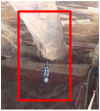Widening the lens of population-based health research to climate change impacts and adaptation: the climate change and health evaluation and response system (CHEERS)
- PMID: 37304117
- PMCID: PMC10248881
- DOI: 10.3389/fpubh.2023.1153559
Widening the lens of population-based health research to climate change impacts and adaptation: the climate change and health evaluation and response system (CHEERS)
Abstract
Background: Climate change significantly impacts health in low-and middle-income countries (LMICs), exacerbating vulnerabilities. Comprehensive data for evidence-based research and decision-making is crucial but scarce. Health and Demographic Surveillance Sites (HDSSs) in Africa and Asia provide a robust infrastructure with longitudinal population cohort data, yet they lack climate-health specific data. Acquiring this information is essential for understanding the burden of climate-sensitive diseases on populations and guiding targeted policies and interventions in LMICs to enhance mitigation and adaptation capacities.
Objective: The objective of this research is to develop and implement the Change and Health Evaluation and Response System (CHEERS) as a methodological framework, designed to facilitate the generation and ongoing monitoring of climate change and health-related data within existing Health and Demographic Surveillance Sites (HDSSs) and comparable research infrastructures.
Methods: CHEERS uses a multi-tiered approach to assess health and environmental exposures at the individual, household, and community levels, utilizing digital tools such as wearable devices, indoor temperature and humidity measurements, remotely sensed satellite data, and 3D-printed weather stations. The CHEERS framework utilizes a graph database to efficiently manage and analyze diverse data types, leveraging graph algorithms to understand the complex interplay between health and environmental exposures.
Results: The Nouna CHEERS site, established in 2022, has yielded significant preliminary findings. By using remotely-sensed data, the site has been able to predict crop yield at a household level in Nouna and explore the relationships between yield, socioeconomic factors, and health outcomes. The feasibility and acceptability of wearable technology have been confirmed in rural Burkina Faso for obtaining individual-level data, despite the presence of technical challenges. The use of wearables to study the impact of extreme weather on health has shown significant effects of heat exposure on sleep and daily activity, highlighting the urgent need for interventions to mitigate adverse health consequences.
Conclusion: Implementing the CHEERS in research infrastructures can advance climate change and health research, as large and longitudinal datasets have been scarce for LMICs. This data can inform health priorities, guide resource allocation to address climate change and health exposures, and protect vulnerable communities in LMICs from these exposures.
Keywords: climate change; climate change and health; digital health; health impacts; low and middle-income country; public health surveillance; response system.
Copyright © 2023 Barteit, Sié, Zabré, Issouf, Ouédraogo, Boudo, Munga, Khagayi, Obor, Muok, Franke, Schwarz, Blass, Su, Bärnighausen, Sankoh and Sauerborn.
Conflict of interest statement
The authors declare that the research was conducted in the absence of any commercial or financial relationships that could be construed as a potential conflict of interest.
Figures







References
-
- Pison G, Duthé G, Masquelier B, Sokhna C, Kante AM, Delaunay V, et al. Estimating mortality from external causes using data from retrospective surveys: a validation study in Niakhar (Senegal). Demogr Res. (2018) 38:879–96. doi: 10.4054/DemRes.2018.38.32 - DOI
-
- Benova L, Owolabi O, Radovich E, Wong KLM, Macleod D, Langlois EV, et al. Provision of postpartum care to women giving birth in health facilities in sub-Saharan Africa: a cross-sectional study using demographic and health survey data from 33 countries. PLOS Med. (2019) 16:e1002943. doi: 10.1371/journal.pmed.1002943, PMID: - DOI - PMC - PubMed
Publication types
MeSH terms
LinkOut - more resources
Full Text Sources
Medical

